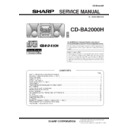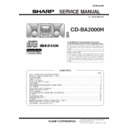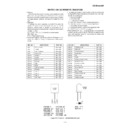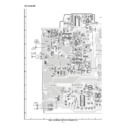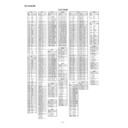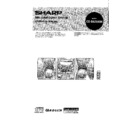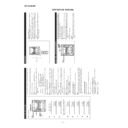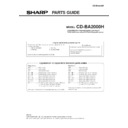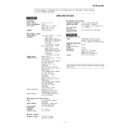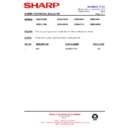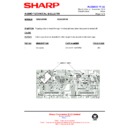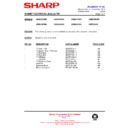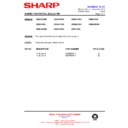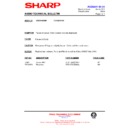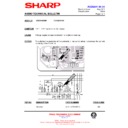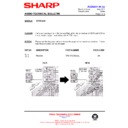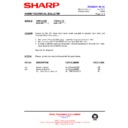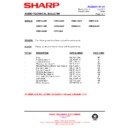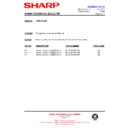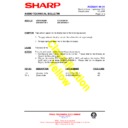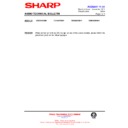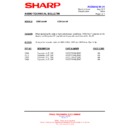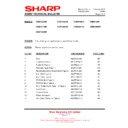Sharp CD-BA2000 (serv.man6) Service Manual ▷ View online
– 17 –
CD-BA2000H
EON summary notice for reference
1. EON-TI/PTY
EON stand-by can be set, only when EON ind. lights up.
While EON ind. goes out (NO EON STATION), EON stand-by can't be set.
If the EON button is pressed, then “NO EON” is indication the display.
While EON ind. goes out (NO EON STATION), EON stand-by can't be set.
If the EON button is pressed, then “NO EON” is indication the display.
2. EON-TI/PTY
Even if switch back ON
→
TN station continue to keep EON stand-by.
3. EON-TI
Don’t switch TN
→
ON during TN broadcast TA. (same item)
4. EON-TI/PTY
EON can be cancelled during receiving ON station by pressing EON button if necessary and switch back ON
→
TN.
5. EON-TI/PTY
EON stand-by is perfectly cancelled (cleared) by pressing EON button 2 times during stand-by or power OFF
or Tun Up/Down or change band or recall pre-set CH.
or Tun Up/Down or change band or recall pre-set CH.
6. EON-TI/PTY
After setting EON stand-by, stand-by items can be confirmed by pressing EON button one time.
7. EON-TI/PTY
EON button function: • EON setting
• Confirm stand-by items
• Cancel (ON
• Cancel (ON
→
TN)
• EON clear cancel (2 times)
8. EON-TI/PTY
After setting EON-TI and EON-PTY stand-by, if when EON data is not transmitted, EON ind goes out and
EON stand-by is automatically cancelled display “NO EON”.
EON stand-by is automatically cancelled display “NO EON”.
9. EON-TI
EON-TI stand-by can't be set. When TP=0,TA=0 (TN) even if EON ind. lights up and the EON button is
pressed then “NO TI” is indication the display.
pressed then “NO TI” is indication the display.
10. EON-PTY
Don’t switch TN
→
ON during TN broadcast same specified PTY. (same item of PTY)
11. EON-TI/PTY
Switch TN
→
ON
→
TN station one cycle.
Never switch TN
→
ON1
→
ON2
→
Other net to other net station.
12. EON-TI/PTY
After switch TN
→
ON station. When ON station is NO RDS, NO signal, TA=OFF or different PTY items.
The receiver switch back ON
→
TN displaying “NO READY”.
13.
During receive ON station. when ON station become to be NO RDS, NO signal, TA=ON to OFF or different
PTY item, The receiver switch back ON
PTY item, The receiver switch back ON
→
TN.
14. EON-TI/PTY
Switch TN
→
ON in case of 2 more stations exist, comparing field strength and switch to the strongest station,
if these signals are same strength, switch to the first previous station.
If same frequency as AF'Sexists in the preset memory, then switch TN
If same frequency as AF'Sexists in the preset memory, then switch TN
→
ON (preset memory station) straight.
In case of exist 2 more preset memories of AF’S,then switch to the preset CH which taken in EON DATA
first, also in this case no concern to field strength.
first, also in this case no concern to field strength.
15.
Even if switch TN
→
ON preset memory straight, that ON station is very weak signal, then search another
AF'S (ON) station comparing field strength and switch to the strongest station as a result. Of all atations of
AF'S are very weak or no good condition, then, switch back ON
AF'S are very weak or no good condition, then, switch back ON
→
TN automatically display "NO READY".
16. EON-TI/PTY
No linkage volume, power ON/OFF, and switch function.
Traffic Programme code
(TP)
Traffic Announcement code
(TA)
Applications
OFF
OFF
This programme does not carry traffic announcements nor does
it refer, via EON, to a programme that does.
it refer, via EON, to a programme that does.
OFF
ON
This programmecarries EON information about another
programme which gives traffic information.
programme which gives traffic information.
ON
OFF
This programme carries traffic announcements but none are
being broadcast at present and may also carry EON information
about other traffic announcements.
being broadcast at present and may also carry EON information
about other traffic announcements.
ON
ON
A traffic announcement is being broadcast on this programme
at present.
at present.
CD-BA2000H
– 18 –
RDS
(Ra
di
o Da
ta
S
y
s
te
m
)
O
P
E
R
A
T
IO
N
RDS is a broadcasting service which a growing number
of FM stations are now providing. It allows these FM
stations to send additional signals along with their regu-
lar programme signals. For example, the stations send
their station names, and information about what type of
programme they broadcast, such as sports or music,
etc.
When tuned to an FM station which provide the RDS
service, the RDS will appear, the station frequency (and
then the station name if sent) is displayed.
The TP (Traffic Programme) will appear on the display
w
hen t
he
re
cei
ved br
oadcast
car
ri
es t
raf
fi
c an
-
nouncements, and the TA (Traffic Announcement) will
appear whilst a traffic announcement is being received.
EON will appear whilst the EON (Enhanced Other Net-
works information) data is being broadcast.
The PTYI (Dynamic PTY Indicator) will appear whilst the
Dynamic PTY station is being received.
Note:
When the TP and TA appear at the same time, an an
-
nouncement is being made.
When only the TA appears, an announcement is not
being made. (See page 24.)
■
Information Provided by RDS
With the CD-BA2000H, you can display three types of RDS ser-
vice. To show them in the display, press the DISPLAY MODE
button.
Each time you press the DISPLAY MODE button, the display will
change to show the following information.
PS (Programme Service):
S
tat
ion nam
e
s
co
m
m
o
nl
y
known will be displayed.
"NO PS" appears if no signal
is being received.
PTY
(Programme
Type):
Programme type will be dis-
played.
"NO PTY" appears if no sig-
nal is being received.
RT
(Radio
Text):
Radio text will be displayed.
"NO RT" appears if no signal
is being received.
Station Frequency:
Station frequencies.
DISPLAY
MODE
(C
ont
inue
d)
Descriptions of the PTY (Programme Type) codes, TP (Traffic Programme) and TA (Traffic Announ
cement)
With the CD-BA2000H, you can search for and receive the following PTY, TP and TA signals.
NEWS:
S
h
or
t ac
coun
ts
o
f f
a
c
ts,
event
s and
pu
bl
icl
y ex
pr
e
s
s
e
d
v
iew
s
, r
e
p
o
rt
a
g
e
and actuality.
AFFAIRS:
T
opi
cal
p
ro
g
ra
m
m
e
ex
pa
nd
in
g
o
r e
n
-
larging upon the news, generally in dif-
fe
rent
pr
esen
ta
ti
on st
yl
e or
concept
,
including debate, or analysis.
INFO:
Programmes whose purpose is to im-
part advice in the widest sense.
SPORT:
Programme concerned with any aspect
of sport.
EDUCATE:
Programme intended primarily to edu-
cat
e,
of
w
h
ic
h
the f
o
rm
a
l ele
m
ent
is
fundamental.
DRAMA:
All radio plays and serials.
CULTURE:
P
rogr
am
m
e
s c
once
rn
ed
w
it
h
an
y a
s
-
pect of national or regional culture, in-
cluding language, theatre, etc.
SCIENCE:
P
rogr
a
m
m
e
s
ab
ou
t t
h
e
n
a
tu
ra
l s
c
ie
n-
ces and technology.
VARIED:
U
s
ed
f
o
r m
a
in
ly
s
p
ee
ch
-b
a
s
e
d
pr
o-
grammes usually of light-entertainment
nat
ur
e,
not
cov
er
ed by ot
her
ca
-
tegor
ies
. E
x
am
ples
include:
quizzes.
panel games, personality interviews.
POP M:
Commercial music, which would gener-
al
ly
b
e
co
ns
id
er
e
d
t
o
be
o
f cu
rr
e
n
t
popular appeal, often featuring in cur-
rent or recent record sales charts.
ROCK M:
C
o
n
temp
o
ra
ry
mo
der
n musi
c,
usu
al
ly
cians.
EASY M:
C
u
rr
ent
cont
em
por
ar
y m
u
sic
co
n
-
sidered to be "easy-listening", as op-
posed to Pop, Rock or Classical, or one
of the specialized music styles, Jazz,
Folk or Country. Music in this category
is
of
ten but
n
o
t al
w
a
y
s
, vo
ca
l,
an
d
usually of short duration.
LIGHT M:
C
la
ssica
l M
usica
l f
o
r gener
al
,
ra
ther
than specialist appreciation. Examples
of music in this category are instrumen-
tal music, and vocal or choral works.
CLASSICS:
P
e
rf
or
m
ances
o
f m
ajo
r or
che
st
ra
l
w
o
rk
s,
s
y
m
p
ho
n
ies
,
ch
am
be
r m
u
sic
etc., and including Grand Opera.
OTHER M:
Musical styles not fitting into any of the
other categories. Particularly used for
s
pec
ialis
t
m
u
s
ic
o
f w
h
ic
h
R
h
y
thm
&
Blues and Reggae are examples.
WEATHER:
Weather reports and forecasts and Me-
teorological information.
FINANCE:
Stock Market reports, commerce, trading etc.
CHILDREN:
For programmes targeted at a young audience,
p
rim
a
ri
ly
f
o
r en
te
rt
ai
nm
en
t an
d int
er
e
s
t,
ra
th
e
r
than where the objective is to educate.
SOCIAL:
P
rogr
am
m
e
s
ab
ou
t
p
e
o
p
le
an
d t
h
in
g
s
t
h
a
t i
n
-
fluence them individually or in groups. Includes:
so
cio
lo
g
y
, hi
st
o
ry
, geog
ra
phy,
p
syc
ho
lo
g
y
an
d
society.
RELIGION:
Any aspect of beliefs and faiths, involving a God
or Gods, the nature of existence and ethics.
PHONE IN:
Involving members of the public expressing their
views either by phone or at a public forum.
TRAVEL:
Features and programmes concerned with travel
to near and far destinations, package tours and
travel ideas and opportunities. Not for use for
A
nnouncem
ent
s abou
t pr
obl
em
s,
de
lay
s,
or
road
w
o
rk
s a
ff
e
ct
ing
i
m
m
edi
at
e
t
ra
v
el
w
h
e
re
TP/TA should be used.
LEISURE:
P
rogr
am
m
e
s
co
ncer
ne
d w
it
h
recr
eat
io
nal
ac
ti
-
vit
ies
in w
hich t
he list
en
er
m
ight
par
ti
cipa
te
.
Examples include, Gardening, Fishing. Antique
collecting, Cooking, Food & Wine etc.
JAZZ:
Polyphonic, syncopated music characterised by
improvisation.
COUNTRY:
Songs which originate from, or continue the mu-
sical tradition of the American Southern States.
Characterised by a straightforward melody and
narrative story line.
NATION M:
Current Popular Music of the Nation or Region
in that country's language, as opposed to Inter-
national `Pop' which is usually US or UK inspired
and in English.
OLDIES:
Music from the so-called "golden age" of popular
music.
FOLK M:
Music which has its roots in the musical culture
of a particular nation, usually played on acoustic
in
st
ru
m
e
nt
s
.
The
na
rr
at
iv
e o
r
st
or
y m
a
y b
e
based on historical events or people.
DOCUMENT:
P
rogr
am
m
e
con
cer
ned
w
it
h
f
a
c
tua
l m
a
tt
e
rs,
presented in an investigative style.
TEST:
B
roadcast
w
hen t
e
st
ing em
er
ge
ncy br
oad
cast
equipment or receivers.
ALARM !:
Emergency announcement made under excep-
tional circumstances to give warning of events
causing danger of a general nature.
NONE:
No programme type (receive only).
TP:
Broadcasts which carry traffic announcements.
TA:
Traffic announcements are being broadcast at
present.
Note:
●
When the unit is in the EON stand-by mode and a programme
is selected, the unit will display "TI" instead of "TA".
CD-BA2000H
– 18 –
RDS
(Ra
di
o Da
ta
S
y
s
te
m
)
O
P
E
R
A
T
IO
N
RDS is a broadcasting service which a growing number
of FM stations are now providing. It allows these FM
stations to send additional signals along with their regu-
lar programme signals. For example, the stations send
their station names, and information about what type of
programme they broadcast, such as sports or music,
etc.
When tuned to an FM station which provide the RDS
service, the RDS will appear, the station frequency (and
then the station name if sent) is displayed.
The TP (Traffic Programme) will appear on the display
w
hen t
he
re
cei
ved br
oadcast
car
ri
es t
raf
fi
c an
-
nouncements, and the TA (Traffic Announcement) will
appear whilst a traffic announcement is being received.
EON will appear whilst the EON (Enhanced Other Net-
works information) data is being broadcast.
The PTYI (Dynamic PTY Indicator) will appear whilst the
Dynamic PTY station is being received.
Note:
When the TP and TA appear at the same time, an an
-
nouncement is being made.
When only the TA appears, an announcement is not
being made. (See page 24.)
■
Information Provided by RDS
With the CD-BA2000H, you can display three types of RDS ser-
vice. To show them in the display, press the DISPLAY MODE
button.
Each time you press the DISPLAY MODE button, the display will
change to show the following information.
PS (Programme Service):
S
tat
ion nam
e
s
co
m
m
o
nl
y
known will be displayed.
"NO PS" appears if no signal
is being received.
PTY
(Programme
Type):
Programme type will be dis-
played.
"NO PTY" appears if no sig-
nal is being received.
RT
(Radio
Text):
Radio text will be displayed.
"NO RT" appears if no signal
is being received.
Station Frequency:
Station frequencies.
DISPLAY
MODE
(C
ont
inue
d)
Descriptions of the PTY (Programme Type) codes, TP (Traffic Programme) and TA (Traffic Announ
cement)
With the CD-BA2000H, you can search for and receive the following PTY, TP and TA signals.
NEWS:
S
h
or
t ac
coun
ts
o
f f
a
c
ts,
event
s and
pu
bl
icl
y ex
pr
e
s
s
e
d
v
iew
s
, r
e
p
o
rt
a
g
e
and actuality.
AFFAIRS:
T
opi
cal
p
ro
g
ra
m
m
e
ex
pa
nd
in
g
o
r e
n
-
larging upon the news, generally in dif-
fe
rent
pr
esen
ta
ti
on st
yl
e or
concept
,
including debate, or analysis.
INFO:
Programmes whose purpose is to im-
part advice in the widest sense.
SPORT:
Programme concerned with any aspect
of sport.
EDUCATE:
Programme intended primarily to edu-
cat
e,
of
w
h
ic
h
the f
o
rm
a
l ele
m
ent
is
fundamental.
DRAMA:
All radio plays and serials.
CULTURE:
P
rogr
am
m
e
s c
once
rn
ed
w
it
h
an
y a
s
-
pect of national or regional culture, in-
cluding language, theatre, etc.
SCIENCE:
P
rogr
a
m
m
e
s
ab
ou
t t
h
e
n
a
tu
ra
l s
c
ie
n-
ces and technology.
VARIED:
U
s
ed
f
o
r m
a
in
ly
s
p
ee
ch
-b
a
s
e
d
pr
o-
grammes usually of light-entertainment
nat
ur
e,
not
cov
er
ed by ot
her
ca
-
tegor
ies
. E
x
am
ples
include:
quizzes.
panel games, personality interviews.
POP M:
Commercial music, which would gener-
al
ly
b
e
co
ns
id
er
e
d
t
o
be
o
f cu
rr
e
n
t
popular appeal, often featuring in cur-
rent or recent record sales charts.
ROCK M:
C
o
n
temp
o
ra
ry
mo
der
n musi
c,
usu
al
ly
cians.
EASY M:
C
u
rr
ent
cont
em
por
ar
y m
u
sic
co
n
-
sidered to be "easy-listening", as op-
posed to Pop, Rock or Classical, or one
of the specialized music styles, Jazz,
Folk or Country. Music in this category
is
of
ten but
n
o
t al
w
a
y
s
, vo
ca
l,
an
d
usually of short duration.
LIGHT M:
C
la
ssica
l M
usica
l f
o
r gener
al
,
ra
ther
than specialist appreciation. Examples
of music in this category are instrumen-
tal music, and vocal or choral works.
CLASSICS:
P
e
rf
or
m
ances
o
f m
ajo
r or
che
st
ra
l
w
o
rk
s,
s
y
m
p
ho
n
ies
,
ch
am
be
r m
u
sic
etc., and including Grand Opera.
OTHER M:
Musical styles not fitting into any of the
other categories. Particularly used for
s
pec
ialis
t
m
u
s
ic
o
f w
h
ic
h
R
h
y
thm
&
Blues and Reggae are examples.
WEATHER:
Weather reports and forecasts and Me-
teorological information.
FINANCE:
Stock Market reports, commerce, trading etc.
CHILDREN:
For programmes targeted at a young audience,
p
rim
a
ri
ly
f
o
r en
te
rt
ai
nm
en
t an
d int
er
e
s
t,
ra
th
e
r
than where the objective is to educate.
SOCIAL:
P
rogr
am
m
e
s
ab
ou
t
p
e
o
p
le
an
d t
h
in
g
s
t
h
a
t i
n
-
fluence them individually or in groups. Includes:
so
cio
lo
g
y
, hi
st
o
ry
, geog
ra
phy,
p
syc
ho
lo
g
y
an
d
society.
RELIGION:
Any aspect of beliefs and faiths, involving a God
or Gods, the nature of existence and ethics.
PHONE IN:
Involving members of the public expressing their
views either by phone or at a public forum.
TRAVEL:
Features and programmes concerned with travel
to near and far destinations, package tours and
travel ideas and opportunities. Not for use for
A
nnouncem
ent
s abou
t pr
obl
em
s,
de
lay
s,
or
road
w
o
rk
s a
ff
e
ct
ing
i
m
m
edi
at
e
t
ra
v
el
w
h
e
re
TP/TA should be used.
LEISURE:
P
rogr
am
m
e
s
co
ncer
ne
d w
it
h
recr
eat
io
nal
ac
ti
-
vit
ies
in w
hich t
he list
en
er
m
ight
par
ti
cipa
te
.
Examples include, Gardening, Fishing. Antique
collecting, Cooking, Food & Wine etc.
JAZZ:
Polyphonic, syncopated music characterised by
improvisation.
COUNTRY:
Songs which originate from, or continue the mu-
sical tradition of the American Southern States.
Characterised by a straightforward melody and
narrative story line.
NATION M:
Current Popular Music of the Nation or Region
in that country's language, as opposed to Inter-
national `Pop' which is usually US or UK inspired
and in English.
OLDIES:
Music from the so-called "golden age" of popular
music.
FOLK M:
Music which has its roots in the musical culture
of a particular nation, usually played on acoustic
in
st
ru
m
e
nt
s
.
The
na
rr
at
iv
e o
r
st
or
y m
a
y b
e
based on historical events or people.
DOCUMENT:
P
rogr
am
m
e
con
cer
ned
w
it
h
f
a
c
tua
l m
a
tt
e
rs,
presented in an investigative style.
TEST:
B
roadcast
w
hen t
e
st
ing em
er
ge
ncy br
oad
cast
equipment or receivers.
ALARM !:
Emergency announcement made under excep-
tional circumstances to give warning of events
causing danger of a general nature.
NONE:
No programme type (receive only).
TP:
Broadcasts which carry traffic announcements.
TA:
Traffic announcements are being broadcast at
present.
Note:
●
When the unit is in the EON stand-by mode and a programme
is selected, the unit will display "TI" instead of "TA".
CD-BA2000H
– 18 –
RDS
(Ra
di
o Da
ta
S
y
s
te
m
)
O
P
E
R
A
T
IO
N
RDS is a broadcasting service which a growing number
of FM stations are now providing. It allows these FM
stations to send additional signals along with their regu-
lar programme signals. For example, the stations send
their station names, and information about what type of
programme they broadcast, such as sports or music,
etc.
When tuned to an FM station which provide the RDS
service, the RDS will appear, the station frequency (and
then the station name if sent) is displayed.
The TP (Traffic Programme) will appear on the display
w
hen t
he
re
cei
ved br
oadcast
car
ri
es t
raf
fi
c an
-
nouncements, and the TA (Traffic Announcement) will
appear whilst a traffic announcement is being received.
EON will appear whilst the EON (Enhanced Other Net-
works information) data is being broadcast.
The PTYI (Dynamic PTY Indicator) will appear whilst the
Dynamic PTY station is being received.
Note:
When the TP and TA appear at the same time, an an
-
nouncement is being made.
When only the TA appears, an announcement is not
being made. (See page 24.)
■
Information Provided by RDS
With the CD-BA2000H, you can display three types of RDS ser-
vice. To show them in the display, press the DISPLAY MODE
button.
Each time you press the DISPLAY MODE button, the display will
change to show the following information.
PS (Programme Service):
S
tat
ion nam
e
s
co
m
m
o
nl
y
known will be displayed.
"NO PS" appears if no signal
is being received.
PTY
(Programme
Type):
Programme type will be dis-
played.
"NO PTY" appears if no sig-
nal is being received.
RT
(Radio
Text):
Radio text will be displayed.
"NO RT" appears if no signal
is being received.
Station Frequency:
Station frequencies.
DISPLAY
MODE
(C
ont
inue
d)
Descriptions of the PTY (Programme Type) codes, TP (Traffic Programme) and TA (Traffic Announ
cement)
With the CD-BA2000H, you can search for and receive the following PTY, TP and TA signals.
NEWS:
S
h
or
t ac
coun
ts
o
f f
a
c
ts,
event
s and
pu
bl
icl
y ex
pr
e
s
s
e
d
v
iew
s
, r
e
p
o
rt
a
g
e
and actuality.
AFFAIRS:
T
opi
cal
p
ro
g
ra
m
m
e
ex
pa
nd
in
g
o
r e
n
-
larging upon the news, generally in dif-
fe
rent
pr
esen
ta
ti
on st
yl
e or
concept
,
including debate, or analysis.
INFO:
Programmes whose purpose is to im-
part advice in the widest sense.
SPORT:
Programme concerned with any aspect
of sport.
EDUCATE:
Programme intended primarily to edu-
cat
e,
of
w
h
ic
h
the f
o
rm
a
l ele
m
ent
is
fundamental.
DRAMA:
All radio plays and serials.
CULTURE:
P
rogr
am
m
e
s c
once
rn
ed
w
it
h
an
y a
s
-
pect of national or regional culture, in-
cluding language, theatre, etc.
SCIENCE:
P
rogr
a
m
m
e
s
ab
ou
t t
h
e
n
a
tu
ra
l s
c
ie
n-
ces and technology.
VARIED:
U
s
ed
f
o
r m
a
in
ly
s
p
ee
ch
-b
a
s
e
d
pr
o-
grammes usually of light-entertainment
nat
ur
e,
not
cov
er
ed by ot
her
ca
-
tegor
ies
. E
x
am
ples
include:
quizzes.
panel games, personality interviews.
POP M:
Commercial music, which would gener-
al
ly
b
e
co
ns
id
er
e
d
t
o
be
o
f cu
rr
e
n
t
popular appeal, often featuring in cur-
rent or recent record sales charts.
ROCK M:
C
o
n
temp
o
ra
ry
mo
der
n musi
c,
usu
al
ly
cians.
EASY M:
C
u
rr
ent
cont
em
por
ar
y m
u
sic
co
n
-
sidered to be "easy-listening", as op-
posed to Pop, Rock or Classical, or one
of the specialized music styles, Jazz,
Folk or Country. Music in this category
is
of
ten but
n
o
t al
w
a
y
s
, vo
ca
l,
an
d
usually of short duration.
LIGHT M:
C
la
ssica
l M
usica
l f
o
r gener
al
,
ra
ther
than specialist appreciation. Examples
of music in this category are instrumen-
tal music, and vocal or choral works.
CLASSICS:
P
e
rf
or
m
ances
o
f m
ajo
r or
che
st
ra
l
w
o
rk
s,
s
y
m
p
ho
n
ies
,
ch
am
be
r m
u
sic
etc., and including Grand Opera.
OTHER M:
Musical styles not fitting into any of the
other categories. Particularly used for
s
pec
ialis
t
m
u
s
ic
o
f w
h
ic
h
R
h
y
thm
&
Blues and Reggae are examples.
WEATHER:
Weather reports and forecasts and Me-
teorological information.
FINANCE:
Stock Market reports, commerce, trading etc.
CHILDREN:
For programmes targeted at a young audience,
p
rim
a
ri
ly
f
o
r en
te
rt
ai
nm
en
t an
d int
er
e
s
t,
ra
th
e
r
than where the objective is to educate.
SOCIAL:
P
rogr
am
m
e
s
ab
ou
t
p
e
o
p
le
an
d t
h
in
g
s
t
h
a
t i
n
-
fluence them individually or in groups. Includes:
so
cio
lo
g
y
, hi
st
o
ry
, geog
ra
phy,
p
syc
ho
lo
g
y
an
d
society.
RELIGION:
Any aspect of beliefs and faiths, involving a God
or Gods, the nature of existence and ethics.
PHONE IN:
Involving members of the public expressing their
views either by phone or at a public forum.
TRAVEL:
Features and programmes concerned with travel
to near and far destinations, package tours and
travel ideas and opportunities. Not for use for
A
nnouncem
ent
s abou
t pr
obl
em
s,
de
lay
s,
or
road
w
o
rk
s a
ff
e
ct
ing
i
m
m
edi
at
e
t
ra
v
el
w
h
e
re
TP/TA should be used.
LEISURE:
P
rogr
am
m
e
s
co
ncer
ne
d w
it
h
recr
eat
io
nal
ac
ti
-
vit
ies
in w
hich t
he list
en
er
m
ight
par
ti
cipa
te
.
Examples include, Gardening, Fishing. Antique
collecting, Cooking, Food & Wine etc.
JAZZ:
Polyphonic, syncopated music characterised by
improvisation.
COUNTRY:
Songs which originate from, or continue the mu-
sical tradition of the American Southern States.
Characterised by a straightforward melody and
narrative story line.
NATION M:
Current Popular Music of the Nation or Region
in that country's language, as opposed to Inter-
national `Pop' which is usually US or UK inspired
and in English.
OLDIES:
Music from the so-called "golden age" of popular
music.
FOLK M:
Music which has its roots in the musical culture
of a particular nation, usually played on acoustic
in
st
ru
m
e
nt
s
.
The
na
rr
at
iv
e o
r
st
or
y m
a
y b
e
based on historical events or people.
DOCUMENT:
P
rogr
am
m
e
con
cer
ned
w
it
h
f
a
c
tua
l m
a
tt
e
rs,
presented in an investigative style.
TEST:
B
roadcast
w
hen t
e
st
ing em
er
ge
ncy br
oad
cast
equipment or receivers.
ALARM !:
Emergency announcement made under excep-
tional circumstances to give warning of events
causing danger of a general nature.
NONE:
No programme type (receive only).
TP:
Broadcasts which carry traffic announcements.
TA:
Traffic announcements are being broadcast at
present.
Note:
●
When the unit is in the EON stand-by mode and a programme
is selected, the unit will display "TI" instead of "TA".

